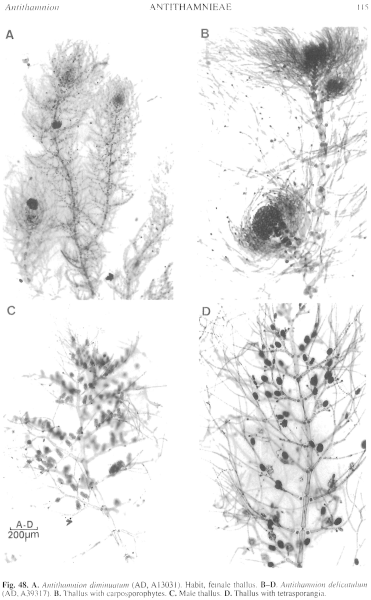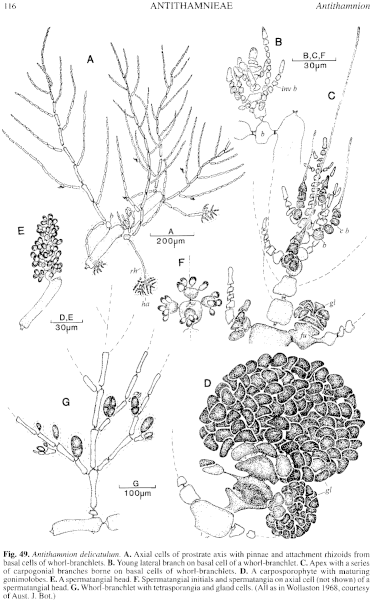|
|
|
|
|
|||||||||||
|
Electronic Flora of South Australia Species Fact Sheet
Phylum Rhodophyta – Order Ceramiales – Family Ceramiaceae – Tribe Antithamnieae
Selected citations: Lucas 1909: 51. Lucas & Perrin 1947: 355. Athanasiadis 1996: 155, fig. 72.
Synonyms
Callithamnion delicatulum Harvey 1855a: 560; 1863, synop.: Iv. J. Agardh 1876: 21. Sonder 1881: 11.
Callithamnion cruciatum sensu Harvey 1859b: 333; 1863, synop.: liii. Sonder 1881: 10? (NON C. Agardh 1827: 637.)
Callithamnion divergens J. Agardh 1876: 19. Tisdall 1898: 502. Wilson 1892: 186.
Antithamnion divergens (J. Agardh) J. Agardh 1892: 21. De Toni 1903: 1410. Guiler 1952: 97. Huisman et al. 1990: 96. Kendrick et al. 1990: 51. Lucas 1909: 51; 1929a: 25. Millar & Kraft 1993: 35. Silva et al. 1996: 378. Wollaston 1968: 281, fig. 15.
Thallus (Fig. 48B) red, delicate, with prostrate axes bearing erect laterals 5–25 mm high with dense apical tufts of decussate whorl-branchlets with mostly alternate distichous pinnules. Attachment by rhizoids (Fig. 49A) from the small basal cells of whorl-branchlets, developing a branched digitate hapteron on the host; epiphytic. Structure. Apical cells 5–10 µm in diameter and L/D 1–2, enlarging below to 40–65 µm in diameter and L/D 2–4 (–6), and to 90–180 µm in diameter and L/D (1.5–) 2–4 in lower erect and prostrate axes; whorl-branchlets formed in decussate pairs, (500–) 600–1200 (–1700) µm long, basal cells isodiametric, 15–35 µm in diameter, pinnules distichous and alternate [occasionally 1 (–3) opposite pairs basally], unbranched or with simple branches; cells of rachis above basal cells 20–35 µm in diameter and L/D (2–) 3–4, decreasing in the pinnules to 8–10 µm in diameter and L/D 3–8 several cells below the apices; gland cells (Fig. 49G) scattered, sparse, borne on short 2 (–3)-celled branches on the pinnules, 10–15 µm in diameter. Lateral branches (Fig. 49B) arise irregularly from the basal cells of whorl-branchlets. Cells uninucleate; rhodoplasts ovoid, elongate in larger cells.
Reproduction: Gametophytes dioecious. Procarps (Fig. 49C) successive below indeterminate apices, with the basal cells of whorl-branchlets acting as supporting cells and bearing 4-celled carpogonial branches. Post-fertilization union with the auxiliary cell occurs via a connecting cell and the auxiliary cell divides to form a foot cell and upper cell which produces a terminal gonimolobe (Fig. 49D) 250–450 µm across of ovoid carposporangia 15–45 µm in diameter, occasionally with later gonimolobes laterally; the axial cell, supporting cell and foot cell usually fuse together, and the carposporophyte (Fig. 48B) is surrounded by an involucre of filaments. Spermatangia occur on special short branches (Figs 48C, 49E) on lower cells of the pinnules, in heads 25–35 µm in diameter and L/D 1.5–2.5, with a central axis of 5–10 cells bearing whorls of 4–6 cells with terminal spermatangia (Fig. 49F).
Tetrasporangia (Figs 48D, 49G) are usually borne on lower cells of the pinnules, ovoid, 35–75 µm in diameter, sessile, decussately or cruciately divided.
Type from King George Sound, W. Aust. (Harvey); lectotype in Herb. Harvey, TCD (Alg. Aust. Exsicc. 529 in lieu of Tray. Set 339, missing).
Selected specimens: Shark Bay, W. Aust., on boat hull (Allender, 1.vi.1966; AD, A31404). St Francis I., Isles of St Francis, S. Aust., 55 m deep (Shepherd, 9.i.1971; AD, A38082). Boston I., Port Lincoln, S. Aust., on Galaxaura marginata, 3–4 m deep (Womersley, 28.ii.1959; AD, A22532), 1 km S of Redcliff Point, Spencer Gulf, S. Aust., 7 m deep (Johnson, 31.viii.1976; AD, A50481). Fisherman Bay, Port Broughton, S. Aust., on Caulocystis uvifera, drift (Womersley, 23.viii.1967; AD, A31802). Marino, S. Aust., on Caulocystis cephalornithos, drift (Womersley, 18.vi.1961; AD, A24866). Petrel Cove, Victor Harbor, S. Aust., on Cystophora retorta, in pools (Womersley, 27.ix.1963; AD, A39317). American R. inlet, Kangaroo I., S. Aust., on Scaberia, drift (Womersley, 31.viii.1950; AD, A15410). Saunders Beach, Kangaroo I., S. Aust., on Caulocystis, drift (Wollaston, 25.viii.1963; AD, A29857). Pennington Bay, Kangaroo I., S. Aust., on Sargassum, drift (Womersley, 22.viii.1954; AD, A19751). Explosive Anchorage buoy, Port Phillip, Vic., on Caulerpa simpliciuscula var. laxa (Macpherson, 23.vi.1957; AD, A27000). Crawfish Rock, Westernport Bay, Vic., on Sargassum, 4 m deep (Watson, 29.v.1974; AD, A45408). Bombay Rock, Low Head, Tas., on mud flats (Cribb 73.12, 15.ix.1950; AD, A16285).
Distribution: Shark Bay, W. Aust. to Westernport Bay, Vic., and N Tasmania.
Taxonomic notes: Wollaston (1968, p. 284) suspected the identity of A. divergens and A. delicatulum, and this was affirmed by Athanasiadis (1996, p. 155). A. delicatulum is based on Harvey's Tray. Set No. 339 which is missing in TCD, but his Alg. Aust. Exsicc. 529 is a duplicate specimen. The species grows on a variety of hosts.
The record of A. divergens by Norris (1987, p. 27, figs 16–18) from South Africa is probably incorrect.
References:
AGARDH, C.A. (1827). Aufzählung einiger den österreichischen Ländern gefundenen neuen Gattungen und Arten von Algen, nebst ihrer Diagnostik und beigeffigten Bemerkungen. Flora (Regensburg) 10, 625–646.
AGARDH, J.G. (1876). Species Genera et Ordines Algarum. Vol. 3, Part 1- Epicrisis systematic Floridearum, pp. i-vii, 1–724. (Weigel: Leipzig.)
AGARDH, J.G. (1892). Analecta Algologica. Acta Univ. lund. 28, 1–182, Plates 1–3.
ATHANASIADIS, A. (1996). Morphology and classification of the Ceramioideae (Rhodophyta) based on phylogenetic principles. Opera Botanica No. 128, pp. 1–216.
DE TONI, G.B. (1903). Sylloge Algarum omnium hucusque Cognitarum. Vol. 4. Florideae. Sect. 3, pp. 775–1521 + 1523–1525. (Padua.)
GUILER, E.R. (1952). The marine algae of Tasmania. Checklist with localities. Pap. Proc. R. Soc. Tasmania 86, 71–106.
HARVEY, W.H. (1855a). Some account of the marine botany of the colony of Western Australia. Trans. R. Jr. Acad. 22, 525–566.
HARVEY, W.H. (1859b). Algae. In Hooker, J.D., The Botany of the Antarctic Voyage. III. Flora Tasmaniae. Vol. II, pp. 282–343, Plates 185–196. (Reeve: London.)
HARVEY, W.H. (1863). Phycologia Australica. Vol. 5, Plates 241–300, synop., pp. i-lxxiii. (Reeve: London.)
HUISMAN, J.M., KENDRICK, G.A., WALKER, D.I. & COUTÉ, A. (1990). The Marine Algae of Shark Bay, Western Australia. Research in Shark Bay. Report of the France-Australe Bicentenary Expedition Committee, pp. 89–100.
KENDRICK, G.A., HUISMAN, J.M. & WALKER, D.I. (1990). Benthic macroalgae of Shark Bay, Western Australia. Bot. Mar 33, 47–54.
LUCAS, A.H.S. & PERRIN, F. (1947). The Seaweeds of South Australia. Part 2. The Red Seaweeds. (Govt Printer: Adelaide.)
LUCAS, A.H.S. (1909). Revised list of the Fucoideae and Florideae of Australia. Proc. Linn. Soc. N.S.W. 34, 9–60.
LUCAS, A.H.S. (1929a). The marine algae of Tasmania. Pap. Proc. R. Soc. Tasm. 1928, 6–27.
MILLAR, A.J.K. & KRAFT, G.T. (1993). Catalogue of marine and freshwater Red Algae (Rhodophyta) of New South Wales, including Lord Howe Island, South-western Pacific. Aust. Syst. Bot. 6, 1–90.
NORRIS, R.E. (1987). Species of Antithamnion (Rhodophyceae, Ceramiaceae) occurring on the southeast African coast (Natal). J. Phycol. 23, 18–36.
SILVA, P.C., BASSON, P.W. & MOE, R.L. (1996). Catalogue of the Benthic Marine Algae of the Indian Ocean. (University of California Press: Berkeley, Los Angeles & London.)
SONDER, O.W. (1881). In Mueller, F., Fragmenta Phytographiae Australiae. Supplementum ad volumen undecinum: Algae Australianae hactenus cognitae, pp. 1–42, 105–107. (Melbourne.)
TISDALL, H.T. (1898). The algae of Victoria. Rep. 7th Meet. Aust. Ass. Adv. Sci., Sydney, 1898, pp. 493–516.
WILSON, J.B. (1892). Catalogue of algae collected at or near Port Phillip Heads and Western Port. Proc. R. Soc. Vict. 4, 157–190.
WOLLASTON, E.M. (1968).Morphology and taxonomy of southern Australian genera of Crouanieae Schmitz (Ceramiaceae, Rhodophyta). Aust. J. Bot. 16, 217–417.
The Marine Benthic Flora of Southern Australia Part IIIC complete list of references.
Publication:
Womersley, H.B.S. (24 December, 1998)
The Marine Benthic Flora of Southern Australia
Rhodophyta. Part IIIC. Ceramiales – Ceramiaceae, Dasyaceae
©State Herbarium of South Australia, Government of South Australia
Illustrations in Womersley Part IIIA, 1998: FIGS 48 B–D, 49.

Figure 48 enlarge
Fig. 48. A. Antithamnion diminuatum (AD, A13031). Habit, female thallus. B–D. Antithamnion delicatulum (AD, A39317). B. Thallus with carposporophytes. C. Male thallus. D. Thallus with tetrasporangia.

Figure 49 enlarge
Fig. 49. Antithamnion delicatulum. A. Axial cells of prostrate axis with pinnae and attachment rhizoids from basal cells of whorl-branchlets. B. Young lateral branch on basal cell of a whorl-branchlet. C. Apex with a series of carpogonial branches borne on basal cells of whorl-branchlets. D. A carposporophyte with maturing gonimolobes. E. A spermatangial head. F. Spermatangial initials and spermatangia on axial cell (not shown) of a spermatangial head. G. Whorl-branchlet with tetrasporangia and gland cells. (All as in Wollaston 1968, courtesy of Aust. J. Bot.)

|
Email Contact: State Herbarium of South Australia |

|